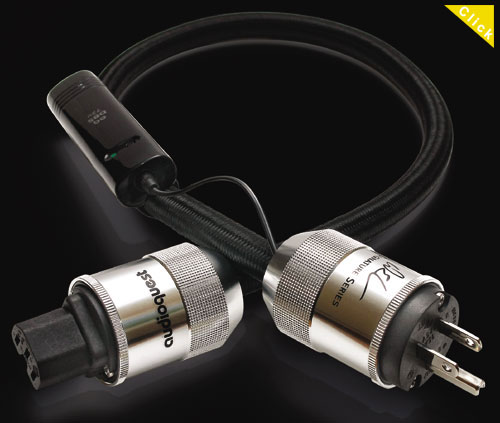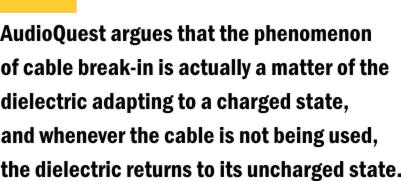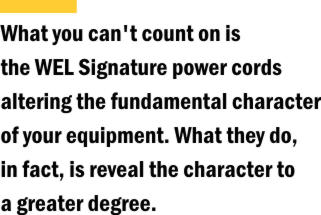AudioQuest • William E. Low Signature Power Cords
ertain words -- "reference," "prestige," "ultra" -- are added to the names of products to dress them up, introduce an air of eminence to what is often an obscure assortment of brand names, numbers and letters. However, when a manufacturer puts the name of the company president on a product, it is making a declaration: that product is special, deserving of more than mere flowery adjectives. AudioQuest has gone a small step further with its William E. Low (WEL) Signature line, including president and founder's Bill Low's initials in script on every cable. I can attest to the sonic worthiness of the line's interconnects and speaker cables. In some specific ways -- soundstage size, image specificity, and transient speed, all of which translate to a more precise and energetic presentation -- they are the finest audio cables I've used. Also in the line are one serious-looking phono cable, a digital cable, and a power cord, the last being the subject of this review.
Even though it is not a signal-carrying cable, the William E. Low Signature power cord was designed, constructed and manufactured just like the other cables in AudioQuest's preeminent line. It uses solid-core Perfect Surface Silver (PSS) conductors, whose primary feature is reduced distortion arising from the conductors' finer grain boundaries, the byproduct of AudioQuest's strict process for drawing the wire. The power cord's positive leg comprises four 19-gauge PSS conductors at the center of the cable in a quad-helix geometry. Around them is a counter spiral of ten 20-gauge PSS conductors, five for negative and five for ground. This results in three 13-gauge PSS conductor groupings. AudioQuest reasons (correctly, in my opinion) that with all of the consideration that goes into the conductors themselves, the terminations deserve just as much attention. Thus, connections for the WEL Signature cables are cold welded -- wire and connector are bonded with silver-impregnated paste under high pressure -- not soldered or spot welded. It is AudioQuest's position that the heat required for either of these widely used termination methods changes the conductor's properties for the worse. Cold welding, on the other hand, ensures that the conductor and connector are "mechanically as one," in the company's words, without the use of heat. It's easy to understand how noise, mainly in the form of radio-frequency interference (RFI), can adversely affect the transmission of relatively tiny audio signals through interconnects and speaker cables, but what about AC through a power cord? Here, in addition to deleterious effects of RFI, there is the distortion on the power line itself to consider, as well as the grunge the equipment can reintroduce. And "consider" is what AudioQuest has done, using the Noise Dissipation System from the WEL Signature interconnects and speaker cables for the power cords. This combines different shielding methods along with metal and carbon-loaded synthetic materials to prevent most RFI from reaching the equipment's ground plane and to address the power-line's intrinsic distortion. WEL Signature power cords also isolate each piece of equipment, preventing them all from contaminating the pool of AC they share.
However, there is a caveat where the WEL Signature power cords are concerned, and it may be one you've already figured out: Power cords are charged with AC even when connected equipment is not turned on. Therefore, what effect does the DBS have when a power cord is used with equipment that's constantly on or constantly receiving AC power? "Some," according to AudioQuest, which cites the ability of a strong DC field to saturate the cord's dielectric. More important, if you use your equipment with sequenced power strips, the kind that provide AC to components in a defined series, the AudioQuest DBS will keep the power cords performing as though they're in perpetual use. The plug and IEC for the WEL Signature power cords are palladium plated over platinum over pure copper. When I suggested to Joe Harley, AudioQuest's vice president, that the plating looked like nickel, he immediately fired back, "Nickel sounds horrible. We would never use it." This underscores the deliberation behind the WEL Signature power cords -- indeed, all of the cables in the line. Nothing about them is casual -- from the choice of conductors to the cold-welded connections to the inclusion of Bill Low's initials. They are truly AudioQuest's ultra prestige reference in power-cord design. A deep WEL udiophile power cords have been around for more than 20 years, but a cloud of doubt still hangs over them. This is definitely thinning, however, if the e-mail I get is any indication. The theoretical arguments against the sonic efficacy of aftermarket power cords are being overrun by reality -- namely, people are not only hearing differences between the cheapie black cords that come with equipment and others designed specifically to improve sonic performance, they are also discerning that within those differences lies true improvement. There is also greater understanding of AC's effect on the audio signal, not just in terms of the quality of the power delivered from the wall socket but also what the audio equipment itself radiates back into the power line. The sonic differences that power cords effect are no less diverse than those of electronics or speakers, and in some cases they are as profound. Tonality, dynamics, soundstaging and resolution are often nudged one way or another, the character of any power cord coming down to a combination of all these things, just as with other audio gear. Describing what the WEL Signature power cords bring to the sound of the products with which they are used doesn't require stressing and straining. The effect is immediate and repeatable. There is a clarifying of the tonal palette, as though gradations in tone become more distinct. Likewise with dynamic shading, large swings occur with greater swelling and panache and the smallest modulations trail off into utter blackness. This is coupled with acute soundstage focus. Up-front images sound more resolved and steadfast, and the very limits of the recording venue expand in all dimensions. It is as though the signal is better delineated from the inevitable noise that comes along with it. Brass is brassier, drums are snappier, and massed strings sound more distinct. The contribution of each musician to the music's texture becomes more elemental.
The defining and focusing of the WEL Signature power cords further reveal what the Reference electronics do so well. Larry Young's great record Unity may be nearly 50 years old, but its dynamic power, as displayed on the Music Matters reissue [Blue Note/Music Matters MMBST-84221], can still tax an audio system, especially as Young leans on the bass pedals. With the WEL Signature power cords, the Audio Research gear sounded more freewheeling with this music, tracking Young's soloing in volume and placing it within the venue with acute precision -- great music and great recording reaching their combined zenith, at least in my experience. In all honesty, however, it would take some doing to make this version of Unity sound polite, congealed and constricted. It's like an automotive test track, while a recording such as Simon & Garfunkel's Sounds of Silence [Columbia/Audio Fidelity AFZ 080] is akin to a residential street. The Audio Fidelity gold CD is a step ahead of its counterpart from Columbia, sounding more corporeal, but there's no denying that the dynamic range is blunted, the soundstage is stark, and the tonality is pale -- all byproducts of the recording itself. The AudioQuest power cords can't work miracles, but they did lay bare the issues with such recordings and, at least in this case, dug more deeply into the soundstage, such as it is, giving a better idea of how the music was constructed in the studio. This is one of the things we want our audio systems to do: delve deeply into the recordings we play, tell us more about them. I also did some mixing and matching of power products: I used a WEL Signature power cord with a Shunyata Research Hydra V-Ray Version II power conditioner; the gear plugged into the V-Ray II used Shunyata Research and Essential Sound Products power cords. The outcome was the same -- improved clarity and better delineation -- though it was not nearly as conspicuous (no surprise). Perhaps it was the case that the WEL Signature power cord's effect was diluted in a stew of other makers' products, as every piece of my system was plugged into the V-Ray II. More likely, the V-Ray II was exerting its significant influence, which is squarely in terms of dynamics and noise, maximizing the former and minimizing the latter. What I took away from this was the belief that the WEL Signature was universal in its application: not just meant for lower-power preamps or CD players, for instance, at the exclusion of power-gobbling amps. It can handle the demands of any equipment -- and even an entire system. Super-cord showdown hile the Hydra V-Ray Version II is a very effective power conditioner, Shunyata Research has reached its place in the audio market largely on the performance of its power cords. The latest models, part of Shunyata's CX series, use hundreds of conductors, all precisely placed, cryogenically treated and terminated with bespoke connectors. And with its new initiative to measure certain aspects of power-cord performance, Shunyata Research will remain highly visible in the power-cord market, even as new competition seems to enter daily. As I've discovered through much experimentation, the three top cords in the latest CX series -- the Python CX ($1195), Anaconda CX ($2000) and King Cobra CX ($3500) -- can be used strategically to great sonic effect and save you money in the process. Yes, it's possible to use pricey King Cobras all around, but "prudence is more satisfying," to quote myself. Using the Anaconda CX and Python CX strategically can yield results that are nearly as impressive. I mention all this in the context of comparing the Shunyata cords to the WEL Signature because AudioQuest also makes other power cords that may, in conjunction with the WEL Signature, offer the same comprehensive effect for less money. No matter the combination, the Shunyata power cords "super-charged" the gear with which they were used, the system sounding more forceful and gutsy. In some ways, this is the other side of the WEL Signature's performance coin, which stresses overall clarity and a character that's seemingly more intrinsic to the components themselves. Does this mean that the Shunyata cords are additive, committing the proverbial sin of commission? That's both hard to say and hard to believe, as power cords don't increase voltage, for instance. Instead, it's easier to comprehend this as a difference in perspective: the Shunyata cords sounding more up-front than the AudioQuest cords' more reserved viewpoint. A musical example demonstrated this particularly well. Hans Theessink's Hard Road Blues [Minor Music 801047] is a remarkable recording of spare, well-played blues. It's on TAB's "The List" because of its revelatory sound, which it achieves through a deft mixture of space and image density. Its soundstage is voluminous and airy, while Theessink's guitar and voice are well detailed and solid, making for a sonic mélange that very few recordings approach and none that I've heard quite equal. With the Shunyata cords, Theessink was distinct from the space around him, his singing and playing more forcefully propelled from the speakers. With the WEL Signature cords, space and presence were in equal proportion; separating one from the other was an act of futility. Perhaps this is the finest of nits to pick, but it does explain the discernible difference in presentation. It would be very difficult for me to say that either of these cords, or musical perspectives, is right, thereby implying that the other is wrong. I will say, however, that certain electronics performed better with one cord or the other. With Lamm M1.2 amps and LP2 phono stage, I preferred the dynamic pop that any of the Shunyata cords brought to their presentation. However, with the Audio Research Reference electronics, the WEL Signature cords were supreme, spreading out a massive soundstage and resolving every inch of it in an evenhanded way. As I've counseled many readers in the past, you can't go wrong with either of these power cords, but one of them will be more right than the other. All's WEL that ends WEL 've met and spoken to AudioQuest president Bill Low exactly once. He's a reserved and philosophical fellow, and his approach to audio design seems to mirror his personality -- serious ideas leading to serious products. While it's true that the WEL Signature power cords, as well as the other cables in the line, have a strong basis in the theory, I am convinced that it is the execution of Bill Low's ideals that makes his Signature line so successful. In many ways, the performance of the WEL Signature power cords mimics that of the matching interconnects and speaker cables. There is great resolving power and dynamic prowess across the line, and with these the sense that everything remains in proportion. While I thought the WEL Signature power cords were an ideal match for Audio Research Reference electronics, the very effective way they address noise, and let the equipment's true character shine through, will ensure stellar results with a broad range of electronics, the higher the fidelity the better. I suppose it could be said that the WEL Signature power
cords have received Bill Low's personal endorsement. They've also earned mine.
|


 Perhaps the
defining feature of the WEL Signature line, and most of AudioQuest's cables, is the
Dielectric Bias System (DBS). An insulated anode and uninsulated cathode inside each cable
are connected to battery packs at the cable's downstream end. The batteries keep the
cable's dielectric constantly charged with DC -- 72V for the WEL Signature power cords --
and thereby ensure that the dielectric never drains its energy as distortion. Because the
battery packs are attached when the cables are terminated, the cables arrive ready to use.
No hundreds of hours of break-in are required before the cables begin to sound the way
they should. AudioQuest argues that the phenomenon of cable break-in is actually a matter
of the dielectric adapting to a charged state, and whenever the cable is not being used,
the dielectric returns to its uncharged state.
Perhaps the
defining feature of the WEL Signature line, and most of AudioQuest's cables, is the
Dielectric Bias System (DBS). An insulated anode and uninsulated cathode inside each cable
are connected to battery packs at the cable's downstream end. The batteries keep the
cable's dielectric constantly charged with DC -- 72V for the WEL Signature power cords --
and thereby ensure that the dielectric never drains its energy as distortion. Because the
battery packs are attached when the cables are terminated, the cables arrive ready to use.
No hundreds of hours of break-in are required before the cables begin to sound the way
they should. AudioQuest argues that the phenomenon of cable break-in is actually a matter
of the dielectric adapting to a charged state, and whenever the cable is not being used,
the dielectric returns to its uncharged state. What you
can't count on is the WEL Signature power cords altering the fundamental character of your
equipment. What they do, in fact, is reveal the character to a greater degree. Of the
products with which I used the cords, this was most apparent with the Audio Research
Reference 5 preamp, Reference Phono 2 phono stage, and Reference 110 amp. Among the many
traits of the current crop of Audio Research Reference electronics is an immense
soundstage -- width, depth and, when the speakers are capable, height -- and realistic
dynamic scaling, the ability to ascend or descend with the music, mirroring the quick pace
and gradual shifts of the real thing.
What you
can't count on is the WEL Signature power cords altering the fundamental character of your
equipment. What they do, in fact, is reveal the character to a greater degree. Of the
products with which I used the cords, this was most apparent with the Audio Research
Reference 5 preamp, Reference Phono 2 phono stage, and Reference 110 amp. Among the many
traits of the current crop of Audio Research Reference electronics is an immense
soundstage -- width, depth and, when the speakers are capable, height -- and realistic
dynamic scaling, the ability to ascend or descend with the music, mirroring the quick pace
and gradual shifts of the real thing.